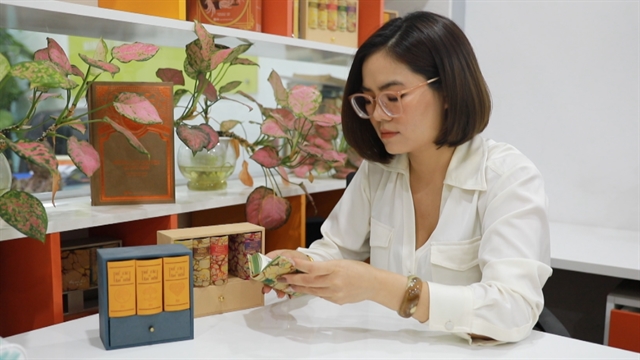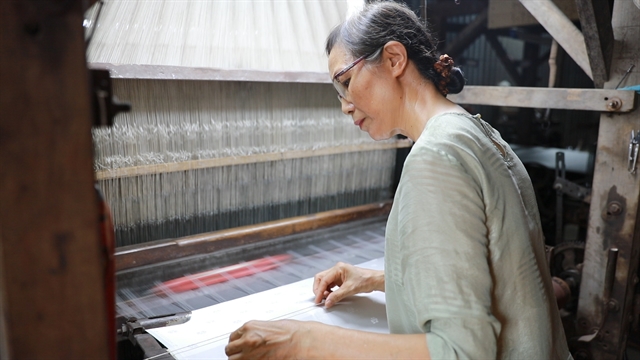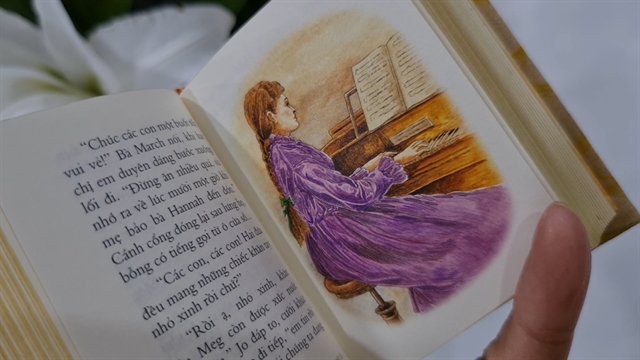 Features
Features

By Kiều Trinh
In times past, miniature books were produced for personal convenience because they could easily be carried in a waistcoat pocket or a woman’s purse. Gradually considered as sophisticated handcrafted works, mini books are not only a source of knowledge but are also exhibits, collectables, and treasured possessions, with some books worth thousands of dollars.
According to Nguyễn Thùy Dương, the founder and CEO of Phúc Minh Books, creating miniature books requires a high level of virtuosity and extreme precision that only perfectionists and passionate people have.
“Miniature books are often the crystallisation of the love of literature and the art of printing because artisans have to spend a lot of time and labour to create a masterpiece. Despite its small size, a micro-volume book fully demonstrates the techniques of binding, content presentation, printing and processing, and almost no error is allowed,” Dương said.
 |
| Nguyễn Thùy Dương checking a set of miniature books. VNS Photo Nguyễn Minh Phương |
In the last two years, Phúc Minh Books has released two sets of these little books: The Body and Soul by Maxence van der Meersch, comprising three books, sized 5.5cm by 7.6cm, and The Little Women by Louisa May Alcott, which consists of five books, sized 6cm by 7.8cm.
These books are produced with techniques first applied in Việt Nam. The book’s cover is covered with silk with a highly smooth surface, woven with a delicate technique so that the silk fibres are immensely tight so that even light cannot penetrate.
In a vast old weaving workshop, wiping the sweat from her cheeks, Lê Thị Kim Thu, an artisan in Vạn Phúc silk village, said: “To weave using a traditional loom, we select the most durable yarns and use delicate techniques to ensure the smoothness and tightness of the warp and weft. As a result, when pressing the silk sheet to the cover, the silk does not shrink, wrinkle or get glued out, ensuring durability and adhesion.”
 |
| Silk weaver Lê Thị Kim Thu at her loom. VNS Photo Nguyễn Minh Phương |
“To cut silk into tiny pieces that would fit in a mini book, we drew out the warp and weft to the required size, then cut along the drawn threads so that the silk was cut beautifully by the right size,” Thu said.
Creating a mini book requires special skills in each stage of the production process, from book cover making, page layout, and illustration to printing and binding.
“Although the book is tiny, I had to choose the right font size so the letters still can be readable. Then when laying out the page, I have to pay attention to the ratio, so the reader’s hand will not cover the words when they are reading. With most of the drawings, I will put them on the right-hand side so that they can attract the reader’s attention easily,” book designer Nguyễn Thị Hồng said.
The illustrations for these books are also exquisite. Trần Minh Tâm, an artist who illustrated the books, told Việt Nam News: “When drawing in a large version, I can show many techniques and use many different strokes. But with the miniature books, the illustrations shrink to a tiny size, only about one-eighth of the size of the normal book, so I have to pay attention properly. If the stroke is too small, it will be clear, and if it is too thick, it will be rough. I have to do many printing tests to see how effective the illustration is and then continue to perfect it.”
 |
| Tiny books are the result of much meticulous and precise work. VNS Photo Kiều Trinh |
To complete a set of books, the maker has to minimise everything from the pages and cover to the box and accompanying gifts. This requires the designers to be very patient, meticulous and skilful. In the binding stage, the stitches must have a certain distance, and the thickness of the spine must be equivalent to the book’s belly.
It requires the worker to be skilled and choose the right sewing needle and thread. Cutting books is also not as simple as with regular-sized books. The book is small but very thick, making it easy to slip when compressing pages together, requiring the cutting blade to be almost absolute. Therefore, the designer must have an almost absolute precision cropping technique.
“In Việt Nam, it is difficult to find a workshop or individual to process these miniature books properly. The products require skilled techniques and to be extremely accurate, but the productivity is very low, so their cost is high. Even so, there are still people willing to secure these products,” Dương said.
“Up to now, Phúc Minh is still the first publishing house to make miniature books, with a minimal number of copies, and they only produce one set of miniature books each year. Therefore, even if the book is a bit expensive, I still can afford it because to me, they are exceptional and rare works,” book collector Từ Xuân Minh said. VNS




